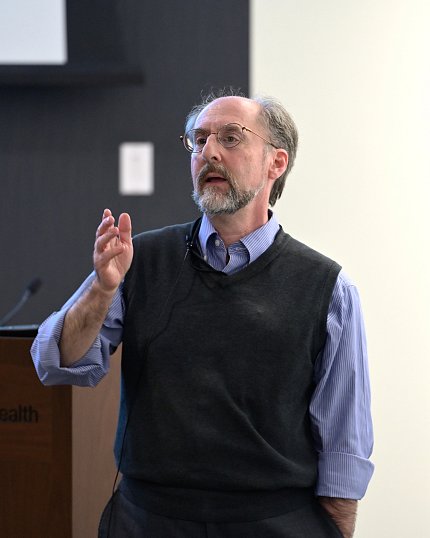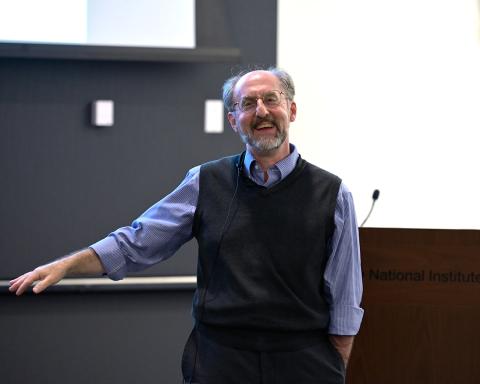Age Is Just a Number
NINDS’s Giniger Explores What’s Killing Us

Photo: Marleen Van Den Neste
The expression “killing me by degrees” has been a staple of blues lyrics, going back at least as far as Robert Johnson’s Preachin’ Blues (Up Jumped the Devil). But in a lecture titled “What is aging and why do we die from it?” Dr. Edward Giniger, senior investigator in the axon guidance and neural connectivity unit of NINDS, argued that “you can’t measure aging with lifespan—they are two different processes…Lifespan does not measure the rate of aging.”
In a well-received hour-long presentation to the proteostasis scientific interest group held recently, Giniger, as lively and enthusiastic an investigator as NIH’s intramural research program has to offer, outlined painstaking investigations of the mechanisms of neurodegeneration, and, in particular, its connection to aging.
Using gene-expression profiling in RNA extracted from the heads of fruit flies, Giniger and his colleagues have shown that about 70 percent of the changes in gene expression that occur in aging flies “have nothing to do with the aging program itself.” Instead, they reflect “their response to the microbial environment, [which] evolves over the lifecycle,” Giniger said.
A quick note on flies: they—like dogs, fish and other critters—share genomic analogs to cellular function, maturation and degeneration with humans, minus the awkward poetry and country songs. Especially useful to scientific investigation is their lifespan: it’s all over, baby blue, in about 40 days, so it doesn’t take long to reach—conclusions.
So intimate have their studies been that Giniger and his team can read fly behavior, from the unpredictability of adolescence to the indolence of late age, which is useful for tracking age-related changes and tying them to gene expression.
The passage of time is not the only metric of interest in studies of aging, according to Giniger and his colleagues. They have also examined the role of the microbiome in prompting the progressive decline of organismal fitness that ends in death. It turns out that “axenic” flies—those raised in a sterile environment—leap, at the age of about 10 days, to a kind of metabolic middle age (30 days or so) and remain there until the end, which is itself delayed by about 20 percent compared to siblings raised under normal, non-sterile conditions.
His team has discovered that only about one-third of the changes that the fly genome experiences over time related to the age measured by the calendar. The group has also applied similar ideas to tease out the non-aging components of neurodegeneration and to examine the role of innate immunity in cellular degradation.

Photo: Marleen Van Den Neste
Crediting a college professor who made him memorize metabolic pathways, Giniger and colleagues can trace many of the metabolic pathways associated with aging and see how they are connected to one another.
The result of their investigations—involving KEGG (Kyoto Encyclopedia of Genes and Genomes) pathways and ANOVA (analysis of variance), among other tools—is that aging is less a Thelma and Louise plunge off a cliff and “more like the Princess Bride fire swamp, where there are a dozen ways to die,” said Giniger.
“Lifespan is not a single entity,” he concluded, “but the net effect of several independent processes…a series of insults that accumulate at various rates.” Or to put it in the vernacular, we are killed by degrees, not simply by the neutral passage of time.
During a brief Q&A session after his talk, Giniger theorized that “a decrease in microbial assault in modern Western culture may be associated with both earlier puberty and later longevity. But I have no evidence.”
Asked whether people might live longer in sterile environments, with less exposure to various microbiomes, he suggested this may already be happening, to an extent:
“It may be why 70 is the new 60,” he said.
